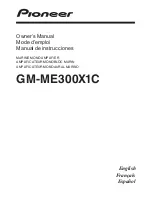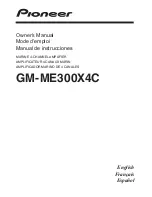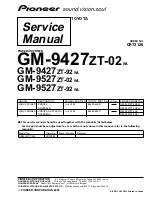
Technical Description
INPUT AMPLIFIER
Each channel input contains a complete seven
transistor low power amplifier. A differential tran-
sistor pair provides high input impedance and low
noise. The differential signals are combined in a cur-
rent mirror circuit which drives a class A amplifier
3tage. The following output stage is a complimen-
tary pair of transistors with class AB biasing. The
output signal drives the metering circuit, headphone
jack, and the high power output amplifier. This
discrete transistor amplifier design was selected for
low noise, low distortion, adequate power output
capability to drive headphones, and freedom from
turn on and turn off transients.
The INPUT LEVEL selector and GAIN controls are
passive attenuators which precede the input
amplifier circuitry. Therefore, the input system to the
amplifier cannot be overloaded when the controls
are correctly set.
In the MONO mode of operation the input signal
feeds only the right input amplifier via the
RIGHT/MONO GAIN control. The output of the right
input amplifier feeds both output power amplifier
sections. When MONO BRIDGE MODE is selected
the left channel input amplifier is used as a phase in-
verter before the left output amplifier. The output
channels are therefore 180° out of phase with
respect to each other which is the correct arrange-
ment for bridge output connections. When MONO
PARALLEL MODE is selected the channels operate
in phase. The channels, of course, also operate in
phase for the STEREO MODE.
OUTPUT POWER AMPLIFIER
The power amplifier inputs are coupled to the In-
put amplifier outputs through an electronic switch.
The switch eliminates turn-on and turn-off transients
and is used for speaker switching. A junction FET
and LED/light dependent resistor network make up
the switch. This combination allows the lowest
possible distortion when the amplifier is on and high
isolation when the output power amplifier is off. The
control signal to the switch is held off for the auto
test countdown time. Therefore, transients that may
come into the amplifier from source equipment will
not be amplified or reach the loudspeaker. Since the
HEADPHONE output and meters are powered by the
input amplifier, their operation is not affected by the
SPEAKER switch or turn on delay system.
The first stage of the output power amplifier is a
differential transistor pair biased for best linearity.
The offset to the differential pair is adjustable. Cor-
rect adjustment allows the lowest possible distor-
tion at low frequencies. A current mirror circuit com-
bines the differential outputs into one signal which
is then amplified by a following class A voltage
amplifier. Both the differential transitors and the
voltage amplifier are supplied by active current
sources. The results are lower distortion and cleaner
turn-on characteristics.
The driver stage consisting of a complimentary
pair of power transitors biased class AB follow the
voltage amplifier. Next, two complimentary pairs of
rugged power transistors make up the power output
stage. All power transistors are mounted on conser-
vatively sized anodized aluminum heat sinks.
Because of a unique connection of the bias network,
the output transistors operate class B and exhibit no
crossover distortion often associated with class B
operation. The heat sinks, therefore remain cool
when there is no output.
The amplifier output signal is fed to the output ter-
minals through the output autotransformer. The
Mclntosh designed interleaved multifilar wound
autotransformer is used to properly match the
amplifier to stereo output load taps for 1, 2, 4 and 8
ohms. The MC 2155 will deliver full power over the
entire audio frequency range at any of these Im-
pedances. The autotransformer also protects
speakers from damage in the event of amplifier
failure. Should a direct current component appear in
the output it is shunted by the autotransformer and
DC cannot damage the speaker.
A Mclntosh patented Sentry Monitoring circuit
constantly monitors the output signal and instantly
reacts to prevent overload of the output transistors.
At signal levels up to rated output this circuit has
high impedance and has no effect upon the output.
If the power output exceeds design maximum, the
Sentry Monitoring circuit operates to limit the signal
to the output transistors. In the event of a short cir-
cuit across the amplifier output or severe im-
pedance mismatch the Sentry Monitoring circuit will
protect the output transistors from failure. Both
positive and negative halves of the output signal are
monitored and protected independently.
POWER GUARD PROTECTION CIRCUIT
The Mclntosh patented Power Guard circuit
eliminates amplifier clipping due to overdrive. The
15




































